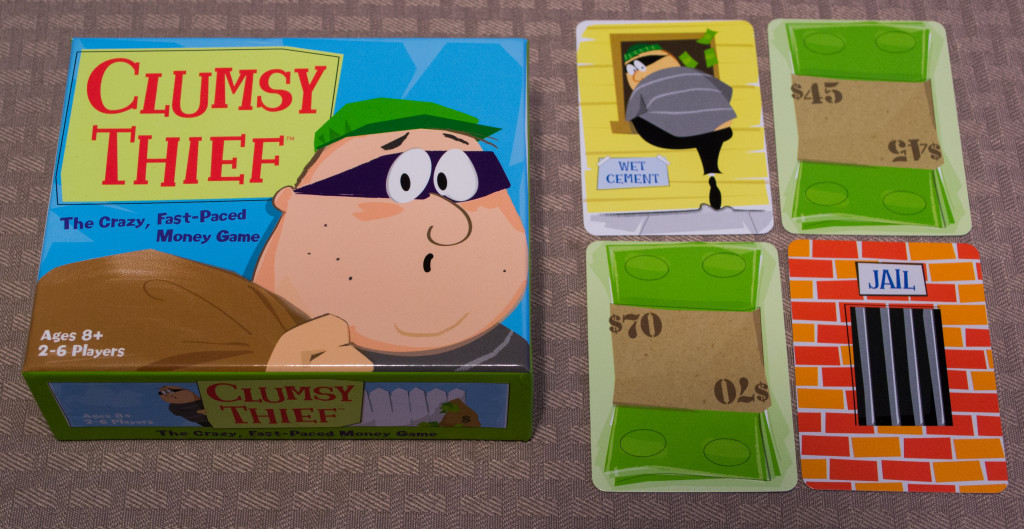If you’re clumsy, then perhaps you shouldn’t be a thief. I mean, what good would you be as a thief if you constantly lost the money you’ve um, “acquired”? It’s good for those TV blooper shows I suppose…but for the thief, not so much. “Clumsy Thief” revolves around this theme, tasking players with stealing money piles from other players in order to have the most by the end of the game. Before we get hauled off to jail to serve hard time, I’d like to thank Game Designer Jeanie Mehran for reaching out and providing me with a press copy for review purposes.
Components
The game includes 94 cards, consisting of 84 money (of varying value), 6 thieves, and 4 jails.
Setup & Gameplay
Setting up the game is as easy as shuffling the deck and dealing seven cards face down to each player. The draw deck is placed face down in the center of the table within easy reach of all players. Players will analyze their cards and separate their money into stacks in front of them, face up. A money stack starts with two cards that add up exactly to $100. Once players are done building their stacks, the game begins.
There are no player turns. Rather, when the dealer says “Go!”, all players may steal money stacks from other players at will. To steal a stack, you’ll play a single card on top of another money stack…the stipulation is that the top card of that stack AND the card you played on top of it MUST add up to $100. You can claim then claim the stack once this is done. For example, let’s say your opponent had a stack that had a $40 on top and a $60 on the bottom. In order to claim it for yourself, you’d need to play a $60 on top of the $40 to make them sum up to $100.
When everyone is done stealing, they’ll each take one new card from the deck and on the dealer’s signal, continue playing. If a player ever has two cards in their hand that add up to $100, they must play them. A thief card lets you steal money stack from other players and yes, a thief can be played on top of another thief. A jail card tops a thief and prevents the stack from moving for the rest of the game…which is a great way to guarantee you points at the end of the game. Number cards can not top thieves or jail cards.
The game ends when someone is out of cards or there aren’t enough card in the deck for every player when drawing. In the case of the latter, cards in player’s hands are discarded. Players count the money in their stacks (thieves and jails have no value) and whoever has the most, wins!
Editor’s Note: The above doesn’t cover all of the rules found in the manual, but should give you an idea as to how the game is played.
The Review
My, this game can sure get messy. This game is incredibly fast-paced, meaning that you’re encouraged to play cards as quickly as possible in order to steal stacks. The faster you grab said stacks and place them in front of you, the faster you can get back to playing cards. As such, it’s possible for the cards to go flying out of order and out of their stacks should someone not be careful in their haste to complete their intended action. This might be okay for some, but my OCD tendencies cause my eye and shoulder to involuntarily twitch every time it happens.
On the plus side, this game does indeed promote a bit of quick thinking which will keep the mind sharp. It’ll also help younger kids who are just starting to learn simple arithmetic. The game’s mechanics make learning math a bit limiting though, as the card you play will always be equal to the value of the card underneath the top card. For example, if there’s a $30 on top and a $70 underneath it, then you’d need a $70 to bring the stack to $100 in order to steal it. To steal that stack again in the future, one would need a $30. Then a $70. Then $30. You get the idea.
I haven’t experimented to know if it’ll work, but perhaps players could be allowed to play up to two cards to bring stacks to $100. With up to three values involved instead of two (one from the top card and two from a player’s hand), players will be able to use their imagination a bit more. It’ll also potentially change the value of the top card to something other than the same two numbers you’ve seen in that stack up to that point. The only downside I can see is that players will go out more quickly this way. One way to get around this is to cut out the ability to add more stacks as you play and only use the ones at the beginning of the game. Players could also increase their hand limit to ten cards. It’ll take some testing, obviously, to see of these ideas would actually work.
All in all, “Clumsy Thief” does what it’s designed to do pretty well…that is, provide a fast-paced family-friendly gaming experience. With a little tweaking or the addition of some variant rules for more experienced gamers, the game could be made even better. If you’ve got younger kids and you enjoying buying games with educational value, then give this one a look. The $14.99 price tag listed on Amazon and the official website (as of 10/25/15) is on par with similar games on the market.
Final Verdict: 7/10
—

